Grover Cleveland: Reformer President
Part 2: Second Term and Retirement The Clevelands went back to New York, where he served in a law firm. Four years later, the Democratic Party again named him their presidential candidate. This time, tariffs were even more on the minds of politicians and voters. Of particular interest was the McKinley Tariff, a protectionist tariff that raised the average duty on imports from 38 percent to 49.5 percent. The Democrats believed in more free-market approaches. As it turned out in this election, so did the majority of Americans. Cleveland easily won re-election (although not a consecutive one), outdistancing Harrison clearly in both popular and electoral votes. Cleveland claimed 277 of the 344 electoral votes on offer, to Harrison's 145. Cleveland, serving his second term, had to contend almost immediately with the worst financial crisis yet seen by the United States. A railroad bankruptcy began the Panic of 1893, which was accelerated by bank failures, a stock market crash, and a sharp rise in unemployment, followed by a number of high-profile labor and transportation strikes the following year. 
The most well-known of those was the Pullman Strike, the first nationwide strike in America. A total of 125,000 railroad workers, representing 29 railroads across the country, refused to work. Also supporting the striking workers were a large number of men whose job it was to throw the switches at railway junctions. Elsewhere in the country could be found sympathizers who obstructed railroad tracks and otherwise acted to prevent transportation of goods along the railway lines. As a result, in large parts of the country, railway transportation was paralyzed. The strikers refused to call off their strike, and President Cleveland sent in U.S. Marshals and U.S. Army soldiers to break up the strikes. The Marshals and soldiers eventually stopped the strike, city by city, but not before violence ensued. Dozens of strikers were killed, and dozens more were injured. One estimate was that property damage (not just in Blue Island but elsewhere) exceeded $80 million. Cleveland, once the strike had ended, ordered a national commission to study the strike and its causes. Cleveland also joined with Congress to create a federal holiday called Labor Day, to honor the nation's workers. The economy, meanwhile, staggered along, not recovering fully until the discovery of gold in the Yukon spurred an Alaska gold rush. 
During his second term as President, Cleveland vetoed even more bills sent to him by Congress. In total, he issued 584 vetoes, more by far than any other President up to that time. Despite his penchant for reform, Cleveland was not a champion of civil rights. He did very little to benefit African-Americans, Native Americans, or Chinese immigrants; on the last issue, he signed into the Chinese Exclusion Act, which prevented Chinese immigrants who had left the U.S. to return. By 1896, Cleveland had lost the support of many in the Democratic Party. The presidential nominee in that year was former Nebraska Rep. William Jennings Bryan. Cleveland left the White House in 1897 and went home to Princeton, where he served as a trustee of that city's well-known university from 1901. He died of a heart attack on June 24, 1908. Other events that occurred during the presidency of Grover Cleveland:
First page > Early Life and First Time > Page 1, 2 |
|
Social Studies for Kids
copyright 2002–2025
David White




